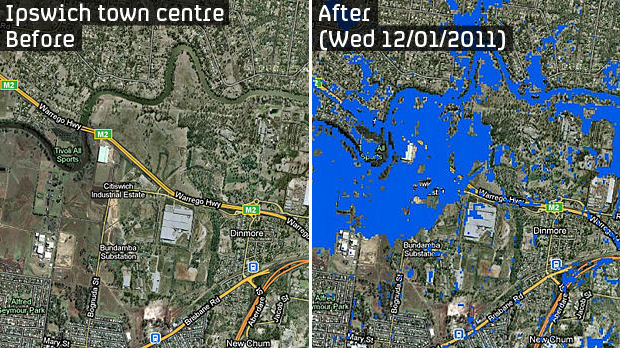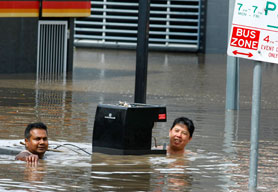Australia floods: waters peak but destruction continues
Flood waters in Brisbane have peaked below the worst levels feared – but 20,000 homes are still flooded and thousands have fled Australia’s third largest city. Jonathan Miller reports from Brisbane.

Images courtesy of Google Maps and UNSW School of Surveying & Spatial Information Systems
The floods have so far killed at least 17 people, left 43 missing and caused billions of dollars of damage in the state of Queensland. However, police confirmed that waters were peaking below the worst case scenario many had feared.
“The Brisbane river has now reached its peak,” a police statement read, as an official weather bureau flood gauge in the centre of the city showed a depth of 4.45 metres. This depth is below expected highs of above 5 metres, and less than a peak in 1974 which caused massive damage.
However thousands of homes and businesses remain submerged, and rescuers are continuing a desperate search for a rising number of people missing after severe flooding swept through Queensland.
Power has been cut in 150,000 homes over concerns the water could cause electrocutions.
State Premier Anna Bligh warned that many more homes would suffer.
“We are now seeing thousands of homes inundated with water up to the roof, many more expected to see significant water damage,” she told a news conference. Authorities are also working to break up large vessels sweeping down the swollen Brisbane river.
The view from Brisbane
There's something surreal about standing at the top of a riverside condominium in a rich, first world country, watching a natural disaster unfold 20 floors below, writes Channel 4 News Foreign Correspondent Jonathan Miller.
Tonight I met the Executive Director of Queensland’s Red Cross in a big evacuation centre. Greg Goebel told me he usually spent his time figuring out how to deploy his teams of volunteers to disaster zones elsewhere – he actually cited Pakistan as an an example.
"We never actually thought we'd have to mobilise in our own back yard," he told me.
Read more from Jonathan Miller on the Australia floods: waters rising in deserted Brisbane
Search for victims
Flash flooding in the Toowoomba area of the state caused huge walls of water to sweep people, cars and houses away.
Ms Bligh said that waters in the area have now receded and rescuers faced a “gruesome search” for victims.
“We’ve now got a number of search and rescue teams all ready to deploy into that valley to really start what might be a very gruesome search this morning for bodies and our police and emergency workers there are going to have a very tough day today,” she said.
Flooding hit the city of Brisbane on Wednesday, causing it to virtually shut down after the severe weather warning. Thousands evacuated from the city and panic buying was sparked as residents fled their homes.
Homes and businesses were deserted as swirling floodwaters rose in and around the city, forcing residents to flee with few possessions to higher ground and to evacuation centres crowded with more than 3,500 people.
‘Total chaos’
A town to the west of the city, Ipswich, has already been hit by the flood which has been described as “total chaos”.
“The water is rising and swallowing up the city. It’s really heartbreaking,” said Ipswich Mayor Paul Pisasale.
Brisbane residents on Wednesday pushed food-laden shopping trolleys through drowned streets, others waded in shoulder-high water to rescue possessions, while boats and pontoons were ripped from moorings in the Brisbane River and smashed into bridges as the muddy brown tide gathered strength.
At flooded intersections people paddled surfboards through floodwaters, balancing their possessions on the deck of the boards, while boats ferried evacuees to dry ground.

“This is my whole life, everything is gone. I never thought it would get this bad,” said Kim Hung, manager of the Salt ‘n’ Pepper catering business, as two friends floated a coffee machine toward higher ground (pictured).
The military is running relief flights with helicopters and C-130 transports.
Economy
The worsening floods are forcing economists to raise estimates of the economic impact, with one central bank board member on Wednesday saying the disaster could cut 1 per cent off growth – equal to almost $13bn, double the previous highest estimate.
The Australian dollar sank to a fresh four-week low, while food prices surged. Queensland crops and distribution networks have largely been ruined by the torrential rains.
Prices for tomatoes have leapt about 200 per cent in two weeks, while beef is up 11 per cent and wheat has risen 4 per cent in four months.
Queensland dam flow reduced to control water
As flood waters peak in Brisbane, the massive volumes of water being released out of the Wivenhoe Dam have been reduced to start effectively managing flood levels in the Brisbane River.
The Wivenhoe Dam, approximately 80km from Brisbane, was built as part of a mitigation strategy after the 1974 flood which killed 14 people. During a flood situation the dam holds back large amounts of water so it can be safely released.
It takes about 24 to 36 hours for water released at the dam to arrive in the city.
At the time of writing the dam is releasing 215,000 megalitres a day - considerably down from an overnight peak of 645,000 megalitres, meaning flood water flowing into the Brisbane River is once again being managed.
The releases follow the dam almost reaching maximum capacity, classified by South East Queensland Water as being 200 per cent.
According to local reports, at the peak of 191 per cent, the depth of the water at the dam wall was just over 74 metres, approximately 60cm below the point water would spill over a secondary spillway resulting in a loss of control.
The dam is now at 189 per cent which, the company said, reflects the current ease in weather conditions.